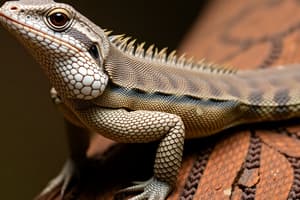Podcast
Questions and Answers
What are the characteristics of birds?
What are the characteristics of birds?
- Bipedal vertebrates
- Most can fly
- All birds have feathers
- All of the above (correct)
What is Archaeopteryx?
What is Archaeopteryx?
The oldest known bird fossil.
What does the term Sinornis refer to?
What does the term Sinornis refer to?
An intermediate between modern birds and Archaeopteryx.
What is a dromaeosaur?
What is a dromaeosaur?
What is Hesperonis known for?
What is Hesperonis known for?
What happens during avian gas exchange?
What happens during avian gas exchange?
What is preening in birds?
What is preening in birds?
Which of the following are types of feathers?
Which of the following are types of feathers?
What does camber refer to in relation to wings?
What does camber refer to in relation to wings?
The three axes of flight include Yaw, Pitch, and ______.
The three axes of flight include Yaw, Pitch, and ______.
What is the Vee formation in flying birds?
What is the Vee formation in flying birds?
Which of the following is true about the superorder Palaeognathae?
Which of the following is true about the superorder Palaeognathae?
What characteristic defines the order Struthioniformes?
What characteristic defines the order Struthioniformes?
What are cassowaries and emus classified as?
What are cassowaries and emus classified as?
What does the order Galliformes include?
What does the order Galliformes include?
What sets hummingbirds apart in their flying abilities?
What sets hummingbirds apart in their flying abilities?
Which order includes the largest number of perching birds?
Which order includes the largest number of perching birds?
What is the scientific name for the Dodo?
What is the scientific name for the Dodo?
What is unique about oilbirds?
What is unique about oilbirds?
Flashcards are hidden until you start studying
Study Notes
Bird Characteristics
- Birds are bipedal vertebrates, primarily adapted for flight.
- Most birds possess the ability to fly, characterized by specialized structures.
- Every bird has a bill, which varies in shape and size.
- Feathers are unique to birds (and some dinosaurs), serving critical functions.
- Feathers are filamentous, soft, flexible, and lightweight; essential for flight and temperature regulation.
Archaeopteryx
- Considered the oldest known bird fossil, dating back 150 million years.
- Demonstrates the evolutionary link between dinosaurs and birds, specifically theropods.
- Found in Germany and noted for limited flying capabilities.
Sinornis
- Represented a more advanced flyer compared to Archaeopteryx.
- Acts as a transitional fossil between modern birds and earlier avian species.
Dromaeosaur
- A 130 million-year-old specimen showcasing evidence of primitive feathers likely used for warmth.
- This small predator is related to Velociraptor, hinting at the evolutionary development of feathers.
Hesperonis
- Known as the "western bird," this genus comprises flightless aquatic birds from the Late Cretaceous period.
Avian Gas Exchange
- Unique respiratory cycle involving air flowing through the trachea and bronchi into posterior air sacs.
- First exhalation moves air from posterior air sacs to lungs, while second inhalation shifts air from lungs to anterior air sacs.
- Second exhalation expels air from anterior air sacs back through the trachea.
Preening
- Birds engage in grooming to maintain their feathers, enhancing condition and waterproofing.
- Involves the application of oil from specialized glands.
Types of Feathers
- Down feathers: provide insulation (e.g., in penguins).
- Contour feathers: shape and streamline the bird’s body.
- Flight feathers: specialized for primary and secondary flight functions.
Camber
- Refers to the wing shape, allowing air to flow faster over the top for efficient lift.
Three Axes of Flight
- Yaw: Dorsal/Ventral axis control.
- Pitch: Lateral axis control.
- Roll: Anterior/Posterior axis control for stability and maneuvering.
The Vee Formation
- Specific bird flight formation providing aerodynamic advantages to each bird in the group.
- Each bird reduces air turbulence for those behind, potentially saving up to 50% energy.
Superorder Palaeognathae
- Includes ratites, which are flightless birds known for their evolutionary traits.
Order Struthioniformes
- Comprised of ostriches, notable for being the largest flightless birds.
Order Rheiformes
- Consists of rheas, large, flightless birds found in South America.
Order Casuariiformes
- Contains cassowaries and emus, both incapable of flight.
Order Apterygiformes
- Features kiwis, small, flightless birds endemic to New Zealand.
Superorder Neognathae
- Encompasses all modern birds capable of flight.
Order Gaviiformes
- Commonly known as loons, specialized for aquatic life.
Order Pelecaniformes
- Includes diverse species such as pelicans, boobies, and frigatebirds.
Order Ciconiiformes
- Contains flamingos, noted for their striking coloration and social behavior.
Order Anseriformes
- Comprises ducks, known for sexual dimorphism in various species.
Order Falconiformes
- Encompasses birds of prey including vultures, hawks, and eagles, recognized for their hunting prowess.
Order Galliformes
- Features heavier, ground-dwelling birds such as turkeys.
Order Columbiformes
- Includes doves, pigeons, and sandgrouse, known for their robust navigation skills.
Raphus cucullatus
- Commonly known as the Dodo, an extinct flightless bird.
Order Strigiformes
- Represents owls, specialized for nocturnal hunting.
Order Caprimulgiformes
- Contains oilbirds, unique for their feeding habits and habitat.
Oilbirds
- The only known birds capable of echolocation, similar to bats.
Order Apodiformes
- Comprises hummingbirds, notable for their ability to fly backward.
Order Passeriformes
- The largest order of birds, includes 69 families of perching birds, with the American Robin as a prominent representative.
Studying That Suits You
Use AI to generate personalized quizzes and flashcards to suit your learning preferences.




